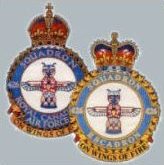Wellington
The Squadron started out with the Vickers-Armstrong Wellington, receiving its first three on 23 Oct 42. The two-engine medium bomber was based on a 1932 RAF design, the first prototype flying on 15 Jun 36. The Mk III variant first flew on 19 May 39, entered service in 42, and remained the mainstay of Bomber Command until enough four-engined bombers were built to replace it. A total of 1519 Wellington IIIs were produced, powered by two air-cooled 1370 horsepower Bristol Hercules XI radial sleeve-valved engines, capable of a 4000 pound bombload, and a defensive armament of six .303 calibre machine guns.
By Mar 43 the Thunderbirds were converting to the Mk X, of which 3804 were built, the main difference being the engines and fuselage; the Mk X was fitted with Hercules XVIs, which were considerably more powerful, and a fuselage structure of light alloy, instead of steel. The aircraft was nicknamed the Wimpy, after J. Wellington Wimpy, the hamburger obsessed character in Popeye. The last mission 426 Squadron flew with the Wellington was a raid on Dusseldorf, 11-12 Jun 43.

A typical group of intrepid Thunderbirds |

In five months of operations, No 426 Squadron lost 104 aircrew: ninety-four killed in action; nine taken prisoner; and one who evaded capture. In three flight-line accidents, one pilot and one ground crew member were injured and one ground crew member was killed. All were struck by propellers.
During this period, Thunderbirds received twenty-eight decorations: one Distinguished Service Order; one bar to the Distinguished Flying Cross (DFC); seventeen DFCs; seven Distinguished Flying Medals; one British Empire Medal; and one Mentioned in Despatches.
In the eight months that the Squadron flew the Wellington, it carried out fifty-nine operations, involving 470 sorties, of which 381 were successful and fifty-three abandoned. Sixteen more sorties were devoted to sea searches. Crews were detailed and aircraft prepared for twenty-nine missions that were cancelled, including thirteen mining, thirteen bombing and three moling operations. The Squadron lost twenty aircraft, including one that was ditched and one from which the crew bailed out. Twenty more aircraft were damaged by flak (six badly), and one crash-landed on return. Accidents damaged thirteen Wellingtons, two so badly that they had to be written off.



F/S J. Stanley, NCO on charge of Maintenance Flight, received the British Empire Medal 1 Jan 43, the Squadron’s first decoration. (This image is of the George VI version, denoted by the crown.)

A couple fitters finish up while a Chiefy (F/S) looks on. This restored Wellington (one of only two in the world) is displayed at the RAF Museum, Hendon, UK

This model of a Thunderbird Wellington OW “M”, was constructed by MCpl R. Nielson and Capt W. Sturgeon in 81, and is housed in the main display case between the entrances of Blanchard Hall, Dishforth Building, Trenton.
